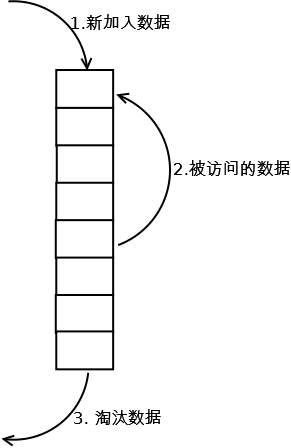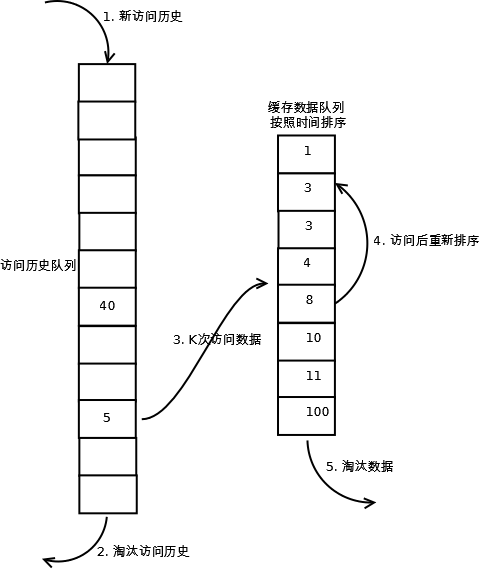1. LRU原理
LRU(Least recently used,最近最少使用)算法根据数据的历史访问记录来进行淘汰数据,其核心思想是“如果数据最近被访问过,那么将来被访问的几率也更高”。
1.1. 实现
最常见的实现是使用一个链表保存缓存数据,详细算法实现如下:

1. 新数据插入到链表头部;
2. 每当缓存命中(即缓存数据被访问),则将数据移到链表头部;
3. 当链表满的时候,将链表尾部的数据丢弃。
1.2. 分析
- 命中率
当存在热点数据时,LRU的效率很好,但偶发性的、周期性的批量操作会导致LRU命中率急剧下降,缓存污染情况比较严重。 - 复杂度
实现简单。 - 代价
命中时需要遍历链表,找到命中的数据块索引,然后需要将数据移到头部
2. LRU-K
2.1. 原理
LRU-K中的K代表最近使用的次数,因此LRU可以认为是LRU-1。LRU-K的主要目的是为了解决LRU算法“缓存污染”的问题,其核心思想是将“最近使用过1次”的判断标准扩展为“最近使用过K次”。

2.2. 实现流程
相比LRU,LRU-K需要多维护一个队列,用于记录所有缓存数据被访问的历史。只有当数据的访问次数达到K次的时候,才将数据放入缓存。当需要淘汰数据时,LRU-K会淘汰第K次访问时间距当前时间最大的数据。详细实现如下:
1. 数据第一次被访问,加入到访问历史列表;
2. 如果数据在访问历史列表里后没有达到K次访问,则按照一定规则(FIFO,LRU)淘汰;
3. 当访问历史队列中的数据访问次数达到K次后,将数据索引从历史队列删除,将数据移到缓存队列中,并缓存此数据,缓存队列重新按照时间排序;
4. 缓存数据队列中被再次访问后,重新排序;
5. 需要淘汰数据时,淘汰缓存队列中排在末尾的数据,即:淘汰“倒数第K次访问离现在最久”的数据。
3. LRU Cache题目
LeetCode上有着样一道题目:
Design and implement a data structure for Least Recently Used (LRU) cache. It should support the following operations: get and set.
get(key) - Get the value (will always be positive) of the key if the key exists in the cache, otherwise return -1.
set(key, value) - Set or insert the value if the key is not already present. When the cache reached its capacity, it should invalidate the least recently used item before inserting a new item.
设计并实现一个LRU缓存的数据结构,并支持get和set方法。首先我觉得这个题目很有意思,能够自己实现一个操作系统中的算法本身就是比较有意思的事情,同时又能够复习一下操作系统的知识,何乐而不为呢。
4. LRU Cache题目实现代码
我们给出一段简单的实现代码,在下面的代码中我们使用map+list的方式来实现,其复杂度是O(logN)
其实,也就是使用红黑树+双向链表的方式来实现,map相当于一个红黑树,用来负责查找一块Cashe是否已经在内存中,而list相当于一个双向链表,能够方便地插入和删除某个元素。我们可以发现,map的查找效率是O(logN),list插入删除的效率是O(1),因此总体的复杂度是O(logN).
下面是我在VS2008上编译通过的代码,但由于LeetCode后台是G++的缘故,没有提交成功,不过我个人感觉把代码贴上还是很有帮助的, 如有不妥之处,还请大家批评指正,共同学习进步:
#include <iostream>
#include <map>
#include <list>
#include <utility>
using namespace std;
class LRUCache{
public:
LRUCache(int capacity) {
m_capacity = capacity ;
}
int get(int key) {
int retValue = -1 ;
map<int, list<pair<int, int> > :: iterator> ::iterator it = cachesMap.find(key) ;
//如果在Cashe中,将记录移动到链表的最前端
if (it != cachesMap.end())
{
retValue = it ->second->second ;
//移动到最前端
list<pair<int, int> > :: iterator ptrPair = it -> second ;
pair<int, int> tmpPair = *ptrPair ;
caches.erase(ptrPair) ;
caches.push_front(tmpPair) ;
//修改map中的值
cachesMap[key] = caches.begin() ;
}
return retValue ;
}
void set(int key, int value) {
map<int, list<pair<int, int> > :: iterator> ::iterator it = cachesMap.find(key) ;
if (it != cachesMap.end()) //已经存在其中
{
list<pair<int, int> > :: iterator ptrPait = it ->second ;
ptrPait->second = value ;
//移动到最前面
pair<int , int > tmpPair = *ptrPait ;
caches.erase(ptrPait) ;
caches.push_front(tmpPair) ;
//更新map
cachesMap[key] = caches.begin() ;
}
else //不存在其中
{
pair<int , int > tmpPair = make_pair(key, value) ;
if (m_capacity == caches.size()) //已经满
{
int delKey = caches.back().first ;
caches.pop_back() ; //删除最后一个
//删除在map中的相应项
map<int, list<pair<int, int> > :: iterator> ::iterator delIt = cachesMap.find(delKey) ;
cachesMap.erase(delIt) ;
}
caches.push_front(tmpPair) ;
cachesMap[key] = caches.begin() ; //更新map
}
}
private:
int m_capacity ; //cashe的大小
list<pair<int, int> > caches ; //用一个双链表存储cashe的内容
map< int, list<pair<int, int> > :: iterator> cachesMap ; //使用map加快查找的速度
};
int main(int argc, char **argv)
{
LRUCache s(2) ;
s.set(2, 1) ;
s.set(1, 1) ;
cout << s.get(2) << endl;
s.set(4, 1) ;
cout << s.get(1) << endl;
cout << s.get(2) << endl;
return 0 ;
}其实,我们可以发现,主要的耗时操作就是查找,因此,我们可以使用hash_map来代替map,因此时间复杂度可以降低到O(1)。
原文链接:LRU Cache 实现
赞赏 微信赞赏
微信赞赏 支付宝赞赏
支付宝赞赏